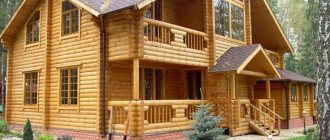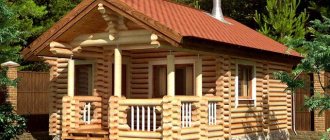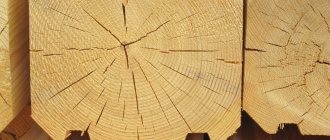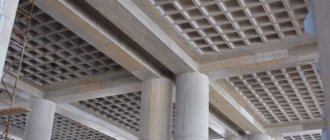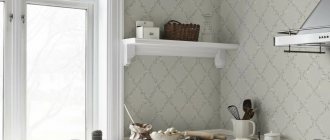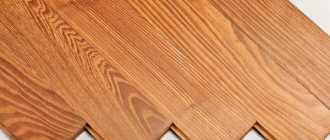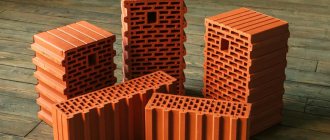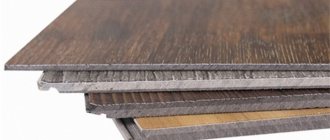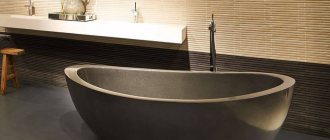The popularity of rounded logs in domestic house building is due to the fact that it allows you to assemble a classic Russian log house, like the one our ancestors built using chopped logs. New technologies have made adjustments to the preparation and characteristics of logs, making the construction process more technologically advanced and faster, and the constructed house more elegant, with smooth crowns and no cracks.
Let us consider in detail the properties and technical characteristics of rounded logs, what it is, what types and types there are, dimensions, parameters, pros and cons, how they are made and used in private construction.
Rounded logs - characteristics, types, sizes, pros and cons
What is a rounded log
A rounded log is milled lumber, which is a fragment of a trunk, cleared of the top, loosest layer of wood. Mechanical processing (milling) ensures the same diameter of the log along its entire length, which in turn increases the strength and stability of the geometry of the finished structure.
Where to start producing log rounding
A log rounding workshop can be located in a production room, a hangar, or even just under a canopy.
The equipment must be protected from the sun and precipitation. Wood blanks and the final products themselves are quite larger in size. The equipment for working with them is also impressive in size. This must be taken into account when choosing premises for production. The workshop is subject to fire safety requirements. Floors and walls are finished with fireproof materials. The drying chamber is usually installed in a separate room. Blanks and finished products are stored separately. In addition, it is necessary to arrange office space for the administration.
Depending on the volume of production, you need to calculate the required number of workers. In one shift, 3-4 people can handle the rounding of logs at the site. From the administration you will need a director, an accountant and a sales manager.
Nuances of choosing a production facility
For the manufacture of rounding, a hangar room or area with a canopy to protect the equipment from precipitation is suitable. Special requirements include high enough ceilings so as not to interfere with the hydraulics moving heavy logs, finishing of walls and floors with non-flammable materials.
A separate room for a drying box or an area under a canopy is equipped (if atmospheric drying is selected). You can save on space for the chamber if you plan to process wood with natural humidity, without chamber drying. But such products are in demand mainly only during the construction season, because a structure made of wood with natural moisture needs to be installed in a short time so that the wood does not have time to shrink.
It is also necessary to equip the office space - no matter where the client comes from (based on recommendations, advertising from the Internet, newspapers or billboards), he will definitely want to see the exhibition sample.
Photos of mock-ups will not help - most potential customers want not only to see the “product in person”, but also to be able to evaluate the smoothness of the finish and the quality of the connections. The ideal “two in one” option is to build a wooden house and place the office of your company in it.
Operation and care
At production sites, the production of finished logs can be up to 800 m per work shift. At home, this is hardly possible, and it is not necessary. To get several pieces of high-quality CBs for future construction per day, follow the rules of safe operation and carry out timely preventive maintenance. So:
Perform routine and major repairs on a homemade log rounding installation in a timely manner. In the first option, complete disassembly may not be necessary if prevention was carried out on time. At this stage, bearings, bolts, fasteners are replaced, the sharpness of cutting tools is checked and, if necessary, they are changed.
Major repairs are carried out only by the efforts of an electric motor service specialist and an assembler. That is, the power unit is removed and sent to the workshop. Doing something yourself, in the absence of knowledge and experience, is not recommended. You can only replace the bearings on the rotating shaft yourself.
Log production involves mechanical processing of wood using special equipment. In this case, the diameter of the rounded log is the same along its entire length. During the production process, the material acquires a smooth surface.
The quality of such work depends on the type and level of machines used.
A rounded log is produced using machines for cutting cups.
Functions
The main function that any rounding machine has is the processing of logs as a body of revolution by milling. But to assemble a log house, simply cylindrical blanks are not enough. And in this case, additional equipment capabilities will come to the rescue:
- excavation of grooves to form various locking connections;
- production of parquet dies, timber;
- sawing of linear products;
- sawing timber into carriages and then into edged boards;
- all stages of log rounding, from roughing to final;
- removal of mounting bowls and compensation grooves.
In this case, the log itself is not reinstalled, but cutters and individual components are changed during the work. The result is parts with a wide range of diameters. The limitation concerns the length of the processed logs: the sleds are designed for seven-meter workpieces. A skillful combination of cutters and working techniques allows you to produce complex wooden structures.
What financial investments do you need to make to open your own log rounding shop?
To open an enterprise with a capacity of 250-300 cubic meters. an amount of 80-120 thousand dollars per month is required. It includes: costs for registration and execution of all documents, rental of premises, purchase of equipment, office equipment and furniture, as well as the purchase of additional tools, carrying out repair work and installing a production line. In addition, do not forget that the enterprise will not immediately begin to make a profit. It will take at least 2-3 months until it reaches the level of self-sufficiency, and until that moment you will finance monthly expenses from your own sources.
Offers for professional work
On the woodworking equipment market there are offers of any price category and for different technical needs. The most popular models are “Sherwood”, “Termite”, “Cedar”, “Taiga”, “Terem” with a full range of functions.
Technical characteristics are presented in the table.
| Model | Log length, mm | Diameter range, mm | power, kWt | Time to process one log, min |
| "Sherwood OF-28C" | 5950–6150 | 200–400 | 7,5 | 15–30 |
| "Termite 280OU" | 6200 | 160–280 | 22 | 30–40 |
| "Kedr OS-100" | 6200 | 160–240 | 7,5 | 15–30 |
| "Taiga OS-2" | 6200 | 160–240 | 9,8 | 30–40 |
| "Terem 8000V" | 8100 | 160–400 | 2,6 | 30–40 |
About the disadvantages and advantages of wood
A lot has been said about this, but let's start with the advantages. Here are the main ones:
- Relatively low density - wood can be easily processed;
- High tensile strength – almost like steel
- Low thermal conductivity. Timber walls 20 cm thick save as much heat as a brick wall more than 60 cm thick;
- It is relatively easy to create various structures from wood, including bent and glued ones;
- Wood is resistant to chemical and mechanical influences, therefore wooden houses are considered wear-resistant;
- The best microclimate, favorable for humans and animals, is created in rooms made of natural wood: optimal humidity, temperature, etc.
- Wood is a very beautiful natural material, with a unique texture and pattern;
- The house kit is lightweight - no powerful foundation is required, which significantly reduces the cost of construction;
- You can save a lot on finishing materials if you use profiled timber or rounded logs;
- If necessary, the log house can be dismantled, moved to another place and reassembled;
- An undeniable advantage for our time is environmental friendliness. When unnatural materials that emit toxins and do not allow air to pass through are increasingly used in construction, wooden houses are becoming housing of the highest class.
Now about the main disadvantages, and there are only two of them:
1. Poor fire resistance, susceptibility to rotting and pest damage.
The first problem is solved with the help of fire retardants - compounds that significantly increase the resistance of wood to fire. The second is with the help of antiseptics that protect against fungus, mold and insects. Both types of impregnations are used today in wooden house construction constantly.
2. Having to wait for wood to shrink is another important disadvantage. This can be solved in different ways. You can use special compensators to ensure uniform shrinkage of the walls. A more convenient option is to choose completely dried material: profiled and laminated timber, dry rounded logs. Then you won’t have to wait six months or a year for shrinkage: you can start finishing immediately after the main construction is completed.
Other disadvantages are also minimized by technological processing during the manufacturing process of materials. Thus, laminated veneer lumber does not change its characteristics when exposed to temperature and humidity: it does not swell or warp, but it is still necessary to protect wooden houses from direct exposure to precipitation and UV rays.
Preparation of necessary documents
If you plan to cooperate with government agencies, large woodworking companies or foreign companies, then it is better to issue LLC documents. In addition, a legal entity is the only option if several founders are involved in the business or you are afraid that the company will go bankrupt (the founders of an LLC do not risk their personal property in such situations).
Entrepreneurs who plan to sell products to individuals or small firms can save on registration by completing individual entrepreneur documents. But, regardless of the organizational and legal form of your business, you must choose OKVED codes that correspond to your activity. In this case, the following are suitable:
- OKVED 20.30
(production of wooden carpentry and building structures). - OKVED 20.10.1
(production of lumber whose thickness is more than 6 mm).
In addition, you need to fill out paperwork with Rospotrebnadzor and the fire inspectorate, and also receive a quality certificate confirming that your product meets established standards. No more permits or licenses are required.
Construction technologies
The construction of wooden houses from round logs is, as a rule, one of the most labor-intensive, time-consuming and high-cost due to the fact that the construction of any such building requires the filigree work of specialists at every stage, from project development and procurement of high-quality wood to the installation of a log house and wiring of communications. The main advantages of a log house - its durability, ability to retain heat, resistance to temperature and humidity changes, natural ventilation and the absence of drafts - depend on how carefully the building design is thought out and how well it is implemented. This includes, among other things, the correct selection of logs, their timely grinding and treatment with antiseptics and fire retardants, correct assembly of the log house and alignment of vertical angles, proper use of insulation and scrupulous monitoring of house shrinkage.
We advise you to study - What the thickness of a parquet board can be in layers and in total and what it affects
To achieve the best results in the construction of modern log houses, Canadian cup cutting using Robert Chambers technology is widely used, which allows minimizing the occurrence of gaps during the shrinkage of the log house, thereby reducing the need for additional insulation and guaranteeing the strength of the connections. Depending on the technical requirements and aesthetic preferences, the log house is assembled from logs of both standard (28-34 cm) and non-standard diameter (over 36 cm); The most popular types of wood are pine and spruce, and to a lesser extent cedar and larch.
Types of rounded logs
All types of logs can be classified as follows:
| Classification feature | Detailing |
| Processing type | — chopped log . In this case, the cylindrical shape is given to the log using a hand plane. They also cut the bowls. This type of log is suitable for those who love the natural style of the Russian hut - log house; — rounded log . Processing is carried out on a rounding machine, due to which ideal geometry and precision of the seats (grooves and bowls) are achieved. |
| Type of drying | — natural moisture log . The vast majority of products on the domestic market are of this type. This is due to the fact that it is quite difficult to ensure uniform drying of the original log, and the cost of the product increases; — thermal log or dried rounded log . Today, manufacturers are mastering the production of an improved product - rounded logs with a given moisture content (18-20%). What it is and its main properties are described below. |
| Type of profile (groove) | - lunar; - Finnish. |
| Wood species (in descending order of popularity and increasing cost) | — pine: Karelian and Arkhangelsk; - spruce; - cedar; - larch; - deciduous species. |
| Groove location | - longitudinal - along the log strictly in the center; - diagonal - used to create non-standard shapes, for example, bay windows; - transverse - landing bowl. |
| Dimensions | — diameter: 160-320 mm; — working height: 139-272 mm. (depending on the diameter of the log); — length: 1...6 m.p.; |
Characteristics of thermal logs
Thermal log
- This is lumber made from thermally modified logs. The new technology involves heat treatment of wood - high-temperature drying of logs in an airless environment.
Features, properties, pros and cons of thermal logs:
drying at a temperature of 125-190 °C. The choice of temperature depends on the density of the wood;
complete absence of resin. At the same time, coniferous wood retains its aroma;
change at the level of cellular structure. Drying allows you to obtain a log with a given humidity, which eliminates the appearance of blue on the surface of the log. In this case, no chemicals are used;
color correction. Thanks to the effect of heat, varying the exposure time and temperature, the manufacturer has the opportunity to give the wood noble dark shades. In this case, the color change is not end-to-end, i.e. does not affect the entire log, but is deep enough (1-2 cm), which eliminates the appearance of light scratches on the surface of the wall;
decrease in thermal conductivity. After heat treatment, wood loses its ability to transmit heat by 0-30%;
increase in surface strength, which increases the log’s resistance to cracking;
- reduction of hygroscopicity due to modification of its capillary structure;
- no torsion defects;
- resistance to biological activity;
- environmental cleanliness;
- increased durability.
The disadvantage is the high cost.
Pricing Features
The price depends on the location of extraction, quality of processing, type of wood, humidity.
The price of lumber per cubic meter depends on the diameter. Approximately: 180 – 190 mm – 7500 rubles, 220 – 230 mm – 7800 rubles, 260 mm – 8000 rubles, 300 mm – 9500 rubles, 320 mm – 11000 rubles.
Price varies depending on factors:
- presence of a diagonal groove;
- type of packaging (film, pallet, tape);
- making holes for installing dowels;
- milling space for window and door trim;
- milling of recesses for installation of window and door fillings;
- impregnation with protective agents.
The final cost is affected by the delivery price . If construction is carried out in steppe regions, delivery will significantly increase the cost of the material.
View of the profile (groove) of a rounded log
The profile or longitudinal groove is selected along the entire length of the rounded log and is designed to ensure a tighter fit of the logs along the length during installation.
Lunar groove
The lunar profile is a longitudinal cut of a semicircular shape. It has become more widespread due to the simplicity of the device.
Characteristics of rounded logs with lunar profile
Finnish groove
It has a more complex tongue-and-groove installation system. It has so-called shoulders - cuts that increase the thermal insulation properties of the joint. The Finnish groove allows you to reduce damage from cracks to a minimum. At the same time, the use of a Finnish groove allows you to abandon the procedure of caulking log walls.
Characteristics of rounded logs with Finnish profile
Marking, diameter, working height, groove width, volume m.cub.
Note. According to the thermal calculation data, a log with a Finnish profile with a diameter of 220 mm. Thermal insulation is equivalent to a log with a lunar profile with a diameter of 280 mm.
Optimal diameter of logs in a house for permanent residence
To keep a house with an area of about 100 m2 warm in Russian latitudes, logs with a diameter of 220-240 mm are sufficient. For large houses over 200 m2, it is more rational to use a log of a larger cross-section - 240–280 mm.
The thermal insulation properties of the future log house wall largely depend on the parameters of the log: the larger the log in diameter, the fewer crowns will need to be laid, therefore, the fewer joints there will be - the main potential source of heat loss. Residents of such a house will not freeze in the cold or swelter in the heat in the summer and will be able to save on heating and purchasing air conditioners.
If we take into account the aesthetic side of the issue, then we need to focus on proportionality and a sense of proportion. A small log house made of thick logs will look more like a bunker than a fairy-tale tower, and a spacious cottage assembled from thin logs will give the impression of an amateur model of a princely mansion made from matches.
Disadvantages of rounded logs
When the construction of a house is completed, the structure shrinks, which lasts for a year to a year and a half.
In the process of using the material, experts have identified a number of shortcomings:
- twisting the product;
- cracking;
- change in shape, arching;
- low fire safety;
- sensitivity to natural phenomena;
When the construction of a house is completed, the structure shrinks, which lasts for a year to a year and a half. During this time, the material shrinks, which leads to cracking of the logs and makes them vulnerable to natural phenomena: precipitation, wind, sun, snow. This occurs due to a violation of production technology. It is known that trunk twisting occurs due to exposure to strong gusts of wind. At the moment of felling, the trunk can spin in the opposite direction. This action usually leads to the formation of deep cracks in the wood. Experts do not recommend using logs with deep cracks, because such material will not be able to provide strength and reliability to the structure. Bending and changing the shape of the product also occurs due to manufacturing errors.
Such products are not capable of performing the function of thermal insulation of a building, and their appearance will quickly lose its aesthetics and beauty. Before buying material, ask the manufacturer, read reviews, ask for quality certificates for the products. If drying is performed poorly, the logs will release moisture, which will lead to an uncomfortable stay indoors. To avoid fire and combustion of the structure, it is necessary to treat the structure with special fire-resistant impregnations. Entrust electrical wiring to professionals, and also adhere to fire safety rules during the operation of the building.
Types of rounding equipment
Depending on the technology, the log rounding machine is divided into:
- Passage – carries out wood processing while moving, without stopping.
- Cyclic – when processing wood, the movement of the log is interrupted. The movement pattern is a cycle of operations.
- And also cyclic installations are classified into two subtypes:
- Cyclo-positional - material processing occurs in the process of advancement relative to the tool
- Cyclo-passing - wood is subjected to woodworking with a tool that itself makes the necessary movements.
According to the mechanism of operation, the machines are divided into:
- Mechanical - require the presence of an operator who adjusts modes, configures, loads and unloads equipment.
- Automatic - the entire processing scheme is carried out by a machine. There are models where a person only needs to load the material.
- Semi-automatic - the installation automatically performs only one cycle of operations, and then the person must start the mechanism again.
A machine for rounding logs in the case of a separate type gives different productivity. Pass-through equipment is more productive, but inferior in terms of correct processing and the formation of pronounced roughness of the material.
What thickness of rounded log to choose
The diameter of the log is almost the main question that needs to be answered before starting to build a house from a log.
In our country, until 1999, all buildings were carried out in accordance with SNiP 2.01.01-82, but it was replaced by a new one - SNiP 23-01-99. The new building climatology differs from its predecessor only in the requirements for the thermal conductivity of enclosing structures. For example, if in the old climatology it was enough to build a brick wall 30 centimeters thick, then according to the new SNiP, a thickness of 60 centimeters is required.
It is worth noting that the requirements for insulation changed in a surprising way precisely at the moment when companies producing insulation materials appeared on the building materials market. It is quite possible that the change in building standards occurred due to the lobbying of the interests of these companies. How then can we explain the fact that people in Siberia spent the winter in houses with walls 20 to 30 centimeters thick, and they still winter, and due to the new snow conditions, they did not become any colder.
In order to answer the question: “What thickness of log should you choose?”, you must first decide for what purpose the house is being built - summer or all-season use. The choice of log thickness will depend on the answer to this question. If you are planning to build a house for summer living, then a thickness of 20-22 centimeters will be sufficient. If you plan to live in this house in winter, then it is better to make the wall thickness 25-26 centimeters. Houses with a wall thickness of 28 centimeters or more will not be warmer, but they will help save a lot on heating costs.
Shown in gray are the logs that will need to be added to get the height of the wall of five 28-diameter logs
We advise you to study - Metal roofing technology
In order to properly build a house, it is necessary to follow a special formula, which is indicated in SNiP: the width of the log is equal to half its diameter. Thus, it all depends on the standard of the log: a twenty-centimeter log will have a groove of 10 centimeters, a twenty-eight centimeter log will have 14 centimeters. How warm your home will be directly depends on the thickness of the groove.
Of course, you can save on the thickness of the log, but this will only mean deferred expenses in the short term. If you build a house to live in all year round from logs with a diameter of 20 centimeters, then you will save on construction, but in winter, all your money will “go down the drain”, since the house will be cool. If you build a house with 8-inch-thick logs, you'll spend a little more during construction, but you won't spend extra money on heating in later years. When building a house with a thickness of 28 cm, a cube of logs costs only 750 rubles more, and for the entire house it costs 100-150 thousand rubles.
In Vasmer Max's dictionary
log dial berno, bervno, berveno, also berevno, bereveno, other Russian. b'ryvno (Ostrom.; see Sobolevsky, ZhMNP, 1886, September, p. 148; I. Schmidt, Vok. 2, 34; Srezn. I, 212), Ukrainian. berveno "log", berevna "pile", blr. Berveno, Berno, St. Slav. br'vno, br'vno δοκός, Serbohorv. brvno, slovenian. br̂vno, dial. Brȗno, Czech břevno, slvts. brvno, Polish bierwiono, bierzwiono, other Polish. birzwno, bierzwno. It is impossible to tear Old Russian from these words. berv "raft", Ukrainian berv "stump", Bulgarian brav “crossbar, bridge; ford", Serbohorv. bȓv “log, bridge, crossbar”, Slovenian. bȓv “bridge; bench; bank (in a boat)", Czech. břev, b. n. břvi “crossbar, bridge”. Reconstruction of Praslav. form is fraught with difficulties. The original form *brъvьno proposed by Bernecker (1, 92) is impossible due to the form in Ostrom. Ev., as well as Russian-Polish. vowels before r. Rozvadovsky (RS 1, 251) tried to explain Russian. log, Czech břevno from *bьrьvьnó, а bervnó, Polish. bierzwno – as a generalization of the plural form. *bьrьвьna; against, see Ilyinsky, RFV 65, 224. Rozvadovsky is right in the sense that one can only proceed from *bьrvьno or *bьrьвьno; see also Sobolevsky, ZhMNP, 1886, September, p. 148. Definition of related nonslavs. forms is very difficult. Old rapprochement with ancient history brú, bryggia, other Sax. bruggia, d.-v.-s. brucka “bridge” with another level of vocalism *brēu̯ā in Gallic. brīva "bridge", lit. briaunà “edge, edge” (Bezzenberger in Stokes 184; Pedersen, Kelt. Gr. 1, 62; Bernecker 1, 92; Mladenov 46; Levi, IF 32, 161) is difficult to combine with the attested glories. forms; see also Ilyinsky (RFV 65, 222) v. Bernecker (ibid.). Pedersen (KZ 38, 322) wants to include the eyebrow here. Possible, initial *brъvь, *brъvьno changed very early under the influence of another word in *bьrvь, *bьrvьno. Log shape Convert. (1, 43) considers borrowing. in Russian from Tslav. Brückner (26) connects *bьrvь with the original meaning. “beam” as “support” from bъrati, berǫ, similar to vьrvь, Russian. he derives rope from *vьr- “to tie, to lock.” Sobolevsky (ibid.) compares with Lat. furca “fork” (see, however, above, on Bertsa and Wald - Hofm. 1, 569 et seq.), Ilyinsky (ibid.) compares - no more successfully - with shaving and related ones. The comparison of Krcek (see Bernecker 1, ibid.) with other Indians is also absolutely incredible. bhárvati “chews”, from where the log – “hewn”.
Recommendations for choosing wood building materials
Comparing rounded logs and profiled timber, you can notice that, despite the significant difference in shape, manufacturing method and properties, the overall quality of these materials is approximately equivalent.
When choosing, you should be guided rather by aesthetic considerations, taking into account the design features of the future home. For those who prefer to build an attractive home in a traditional style without unnecessary decorative elements, it is worth choosing logs as a material, while those who are fans of a more modern style will like timber
As for the cost, for timber and logs it is approximately the same and the service life of the material does not differ significantly.
Advantages of a homemade machine
A do-it-yourself rounding machine has certain advantages:
- Low wood consumption.
- Obtaining material for any of your own needs.
- Achieving good quality of the resulting logs.
- Having a machine at hand.
Of course, like any purchased machine, homemade equipment requires the purchase of component parts. But processing wood using your own equipment turns out to be more suitable for the personal purposes of using the resulting log. Achieving certain technical properties of products occurs in the presence of home-made rounding equipment.
General concept of rounded logs, technology of its production
Such a modern building material as a rounded log is a tree trunk, freed from branches, specially processed on a complex of woodworking machines, having a smooth and even cylindrical shape, the same along its entire length.
To obtain the specified building material, larch and almost all coniferous trees are used. The diameter of the logs can be different and range from 160 mm to 320 mm.
All stages of rounded log production can be divided into the following:
- sorting;
- cylindrical;
- slicing;
- cup;
- final.
The sorting stage of production includes the distribution of incoming wood by diameter, removal of branches, trimming of the butt, and treatment of the surface of the trunks.
The rounding stage of production consists of the actual rounding, i.e. giving the tree trunk, cleared of the top layer, a perfectly even and smooth appearance. The entire production process is completely mechanized. The source material is fed by a hoist into the processing zone, where it is securely clamped by durable mechanisms and processed on special machines, which are of the pass-through or positional type. It should be noted that on through-type machines the processing process is much faster, but the log is obtained with a slight curvature. Positional woodworking machines give the log an ideal shape, but this process will take much more time.
The cutting stage of log processing includes cutting blanks of special sizes on a cross-cutting machine in accordance with the required house design.
At the cup stage of production, the connecting elements of the logs - bowls - are made. Here, laser marking is used for greater accuracy. Bowls can have Russian and Finnish profiles, each of which has its own adherents. If you use high-quality insulation and with proper installation, any profile will be good.
And finally, the final stage of work includes treating rounded logs that are ready for building a house with fire retardant and antiseptic compounds and fungicides, which significantly increases their service life.
Complete sets of wooden houses are packed in transport packages and sent to the assembly site.
Profile forming equipment
The production of edges and grooves of rounded logs is carried out using saws or specialized cutters.
Depending on the type of machine and its configuration, these operations are performed either simultaneously, together with the formation of a cylindrical log, or in an additional pass. Of course, the first option is preferable in terms of processing speed and overall performance.
Depending on the type of cutting tool, the cylindering process is performed:
1) Turning
The main movement is the rotation of the workpiece or tool, during which chips are formed continuously.
The cutting module can be:
- rotor (female head with a set of round cutters for roughing and finishing gouging) - optimal equipment for machine tools that does not cause difficulties in reconfiguration;
- Passing cutters (angled, oblique knives) are an effective, but outdated technology, the use of which requires the participation of a qualified specialist.
2) Milling
The main movement is rotation of the tool:
- two longitudinal cutters;
- end mills with longitudinal feed;
- conical end mills with longitudinal feed.
The most common option today is end-conical cutters. But for pass-through machines, profile ones are considered the most promising.
On a positioning machine with a movable milling unit, the profile is made after the cylinder has been formed. The rotation mechanism is blocked, cutters/saws are attached to the support. In this case, the speed of reinstallation and correct adjustment of the equipment is crucial, otherwise significant downtime will result.
On most pass-through machines, milling and sawing units are included as standard. They are located in the direction of movement of the log, behind the cutting module. The straightness of the edges of the grooves, as well as the formation of the cylinder itself, directly depends on the degree of curvature of the feedstock.
Despite the fact that turning is recognized as a more accurate technology for obtaining an ideal cylinder, the quality of the cut does not particularly depend on the type of machine - only on sharpening the tool, its correct setting and operation
It is important that the workpiece setting bases are maintained between operations - any reconfiguration leads to a loss of manufacturing accuracy of various structural elements. In this regard, positional type equipment with a fixed position of the log is recognized as the best
On such machines, deviations in dimensions can only occur if the cutting tools are severely worn or the frame structure is insufficiently rigid.
How to choose the right rounded logs
When building a wooden house or bathhouse, it is important to choose the right logs, because the quality of the materials directly affects the durability and appearance of the future structure. Choose a construction company that not only builds, but also independently produces rounded logs
Such companies are responsible for both construction work and the quality of building materials.
A construction company’s own lumber production plant is a guarantee of the reliability and durability of the logs. In addition, such companies save on delivery and intermediaries, which reduces the cost of final building materials.
Before construction, find out where and how raw materials are procured, where wood is brought from, delivery conditions and storage of products. Check for certificates and, if possible, visit the factory to check the production and quality of the logs. Please note that not all manufacturing companies carry out antiseptic treatment! Therefore, before purchasing materials, be sure to clarify this fact.
A high-quality rounded log is characterized by the following features:
- yellow or dark yellow color of the trunk;
- absence of wormholes and rot, mechanical damage and resin pockets, large knots;
- small natural defects and the presence of knots of small diameter are allowed;
- blanks of one type of wood and one diameter;
- smooth and untwisted trunks with a dense, even cut;
- At the end of each product there is a marking that indicates the specification;
- It is advisable to choose logs that were cut down in winter. In winter, the tree is more resistant to moisture.
The MariSrub company provides only high-quality logs manufactured in accordance with GOST standards. Storage, transportation, loading and unloading of materials is carried out in accordance with the rules for transporting timber and long cargo, which eliminates any damage and contamination of the surface of the materials.
We have our own plant for the production of rounded and chopped logs, which are subjected to careful and gentle processing, and antiseptic treatment is mandatory.
“MariSrub” craftsmen not only produce building materials themselves, but also build turnkey houses. Specialists will perform a full range of work, which includes the creation of a project and installation of a log house, installation of the foundation and roof, installation of communications and finishing.
Basic requirements for product quality
All material for future construction and its preparations must be made from the same type of wood
Each manufacturer, when cylindering wood, can produce different results. Of course, it is difficult for an ordinary buyer to understand what requirements exist for the quality of the material. There are several points that will help you choose good material for your country house. Basic requirements for product quality:
- all material for future construction and its preparations must be made from the same type of wood;
- the log must be free from mold, black spots, rot and damage of any kind;
- to obtain acceptable moisture content of the product, the log must be made from dead wood;
- deviations and curvatures of the product must be normal according to the data specified in the product specification;
- each product must be marked; logs are marked on the end part;
- the process of storage, transportation or unloading must be carried out carefully, the products must be clean and undamaged;
If you feel any doubts, ask for a product quality certificate, ask the sellers in more detail about the material, manufacturer, and production technology.
Technology for the production of rounded logs
Installation
For work, an old sawmill is used, on which the body is replaced with a stop and tailstocks for clamping an unbarked trunk. A tapered or other roller bearing is installed as a holder. In order for the log to easily rotate along its own axis, you will need an additional motor; manually the process will take a long time.
To move the cutter, the simplest solution is to lay a rail track. There is no need to drag heavy whips by hand. The distance between the transverse sleepers, which reinforce the structure and on which the rail is attached, is no more than 1 m; for installation, timber impregnated with special compounds or ready-made sleepers are used.
Installation of a homemade machine for rounding begins with assembling the frame. Using a welding machine, its sections are prepared separately. And during assembly, they check with a level so that the structure is in the same plane. An error of 0.5 mm per meter is allowed, since perfect evenness will still not be achieved, and a heavy log will smooth out the discrepancy in the future.
The milling unit is strengthened and assembled from lathe parts. After all, in addition to rounding, you need to cut out a cup on the barrel. This requires a special vertical cutter, which is made independently or ordered from the manufacturer’s catalog.
Now connect the motor for rotation. Immediately provide a power supply with the recommended voltage in the room intended to be a home sawmill; the power cable must go separately and be connected to an independent panel, otherwise constant knocking out of household appliances in the house cannot be avoided, which cannot affect their operation. The engine is strengthened with anchor bolts. The correct connection is indicated on the case; the movement of the power head must coincide with it. If there is a discrepancy, swap the phases.
We advise you to study - Metal tiles or corrugated sheets - which is better to use as a roof
Connection cables for various components are installed over the entire length of the finished machine with a margin. Safety of use lies in strengthening them above the machine with flexible holders. Do not let the cable sag, much less touch the work surface - cutting it is fraught with consequences.
Before putting into operation, the machine for rounded logs is checked for parallelism of the axes of the headstocks, front and rear. The moving cutter must run exactly horizontally. If this is not done, the least trouble that occurs during operation is the curvature of the barrel. Large – failure of the entire system. In addition, the error of parallel lines leads to the play of the log, especially with poor fixation.
Classification
Experts propose to classify rounding machines according to five parameters:
- type of mechanism;
- the method of moving the log;
- level of automation;
- drive power type;
- diameter of the workpiece used (minimum – 80 m, maximum – 500 m).
Two types of mechanisms are used in installations. The first is a pass-through (rotary) one, which allows you to continuously move the wood through the cutter. The second is cyclic (turning), in which processing is performed by repeating a cycle of actions.
If cyclic actions are performed by a cutting tool, the machine is classified as a cyclo-pass type, and if a log moves, it is classified as a cyclo-positional type. In the mechanisms, logs have the ability to both rotate and move rectilinearly along the guides.
Positive aspects of log material
Mechanized wood processing gives rounded timber a number of positive qualities that are not inherent in other materials used in construction. Namely:
- Ecological cleanliness. In the process of preparing logs, no harmful substances are used, which allows the material to remain absolutely safe for humans. In addition, the resins released by wood during operation have powerful antiviral and antiseptic properties, which have a beneficial effect on the human body.
- Appearance. Rounded logs (beams) are considered the most attractive type of building materials made from natural wood. Buildings made of round timber fascinate with their beauty both outside and inside, and no additional treatments are required.
- Easy to assemble. The presence of markings and grooves for joining logs can significantly reduce time and labor costs during the construction of a building. The structural elements fit as evenly and tightly as possible to each other.
- Availability. Great competition between round timber manufacturers forces them to strictly control the quality of their products and keep the cost of materials at a minimum level.
Self-production of a rounding machine for wood processing
Since ancient times, humanity has used trees to build housing. This material is widespread, does not require complex preparation and retains heat well. Nowadays, wood can be subjected to any treatment to give the desired shape to the log. To obtain even logs with the same cross-sectional area, rounding machines are used.
This installation allows for various wood processing operations:
- Wood rounding.
- Making grooves.
- Production of edged boards.
- Obtaining elements for parquet.
- Trimming boards.
- Production of timber.
- Milling smooth logs.
- Sawing wood onto a carriage.
Rounding machines are used in sawmills, large industries and in private households. The main function of the equipment is to remove the top layer of wood using a milling cutter and various types of knife tools.
Negative qualities of rounded logs
- damage to the wood layer;
- twisting and unwinding;
- sagging;
- the appearance of cracks on a separate element;
- small diameter;
- high humidity in the first few years after construction;
- application of innovative technologies;
- fire hazard.
One of the disadvantages of the material is curling and cracking, which lead to heat loss and increased humidity.
When the logs are processed, the conveyor method is used
But this is still not manual processing, where each log is given special attention. A mechanical effect occurs on the densest layer of wood, and the internal balance of the surface is disrupted
Over time, logs can become damaged.
When a tree is in its natural environment, it is affected by many factors. For example, wind, rain, blizzard, etc. Thanks to this, the tree seems to “twist”, forming a spiral. And when it is cut down, the reverse process occurs.
It begins to spin in the opposite direction. If the wood was processed manually with an ax, the dense layer, the crust, remains intact and the unwinding process does not start. And if the log was impacted mechanically and this layer was damaged, that is, it was rounded and the unwinding process was started. And he goes much faster. After all, nothing will delay him. As a result, you can get a lot of damaged logs, which are not only replete with cracks of various sizes, but can even break.
When a specialist manually processes a log, he carefully studies the structure of the wood. Conveyor is a machine. And she, naturally, does not possess such skills. Consequently, crooked trunks are also processed. As a result, during the assembly of a house from rounded logs, curved logs do not fit well with normal straight ones and stick out from the walls. This compromises the integrity of the building, adversely affecting both its thermal insulation and appearance.
When even minor cracks appear in the logs, the level of thermal insulation is compromised.
Precipitation is more strongly reflected on logs, and as a result, the appearance of the house deteriorates.
Due to high humidity, without special treatment, mold and rot may form on logs.
When living in cold climates, you should definitely consider the diameter of the logs. It is best to use logs with a diameter of over 30 cm. But for rounded logs this is a real problem. Logs of such parameters are very difficult to select.
You should definitely take into account the fact that in the first few years after construction, increased humidity will be observed in a house made of rounded logs. Not all manufacturers dry the material before processing. This is a very expensive undertaking. And the drying process occurs already in the finished object, which can explain the excess moisture. This also occurs due to damage to the protective layer during processing. If the logs are processed by hand, drying out is usually not as noticeable.
In order to prevent the trunks from unwinding and bending, metal rods are driven into them. They should be checked and tightened if necessary within five years.
Due to the fact that wood itself is easily flammable, and even if it is impregnated with various kinds of compounds it will even burst into flames in seconds. If you are planning to build such a house, entrust all electrical connections to professionals.
Rounded logs are a chic traditional material that not only has maximum environmental friendliness, but is also quite convenient for the quick construction of small buildings.
It has a natural appearance, durability and wear resistance, and if all technologies are followed, it is in no way inferior in comfort to modern cottages made from other materials.
- Some, looking at such houses, have a strong association with an old village hut, and stereotypes appear. The similarity is only external, since the design of these houses, with all its simplicity, assumes the presence of all communications and amenities
- In a standard house of 36 square meters, 2 families can live here, without experiencing overcrowding or similar problems. In addition, a log house can be built by a small team of workers or even independently; practice shows that it is quite possible to fit it in in the shortest possible time
- A hand-cut house is a more expensive pleasure, but not always of better quality
- The pleasant and warm color of the wood is always pleasing to the eye, and the well-thought-out shape of the logs makes it very easy to stack them on top of each other: you obviously don’t need the help of a highly qualified team
However, log houses have their drawbacks, which are important to work out in time.
For what purposes is it suitable?
Calibrated raw materials are lightweight compared to block and other materials. There is one peculiarity in the construction process - there is no need to build a massive deep foundation. A strip foundation is perfect as a base; it is quick and easy to do.
Based on this, you can understand what structures can be built from rounded logs:
- baths;
- residential buildings;
- cottages;
- winter houses;
- hunting lodges;
- houses with an attic;
- buildings with a veranda;
- garages.
Most often, rounding is used for the construction of bathhouses and log houses. Such structures resemble houses from a fairy tale - wood decorated with carved ornaments. But today everything can be done in a modern manner.
Load-bearing walls are erected from logs and partitions are made indoors. Window blocks are inserted into the walls, and doorways are made in the partitions. Almost the entire house is made using wood - in some places it is replaced with timber for ease of construction.
Cottages, winter and hunting lodges - all these buildings look aesthetically attractive and attract with their beauty and inner comfort. The walls will provide excellent heat retention inside the room, so there will always be a comfortable temperature there.
Since logs are considered a universal building material, you can use it to build a house with an attic or veranda. To cut the desired areas, just use a saw.
Garages and outbuildings also look original if made from calibrated logs. Here, too, there is no need for a deep foundation; it is enough to remove the walls and properly arrange the roof.
What are the disadvantages?
Along with a lot of advantages, there are also a number of disadvantages that are endowed not only with the material, but also with wooden houses built from it.
Rounded timber is characterized by long-term shrinkage, so before moving into such a building, it is necessary to let it stand for at least a year. It is possible to reduce the shrinkage time of a building by using thoroughly dried building material, however, such products are several times more expensive than other logs.
The second disadvantage is that during the drying process, rounded timber tends to crack, bend and untwist, which can lead to severe deformation of the building. You can avoid such troubles by using dry timber that has been drying for several years. You can smooth out the effects of shrinkage of wet wood by driving metal pins into the log (during the process of assembling the house).
It should also be noted that all wooden materials have a high fire hazard and susceptibility to rot, but the timely use of antiseptic solutions and fire-fighting impregnations can reduce these problems to almost zero.
